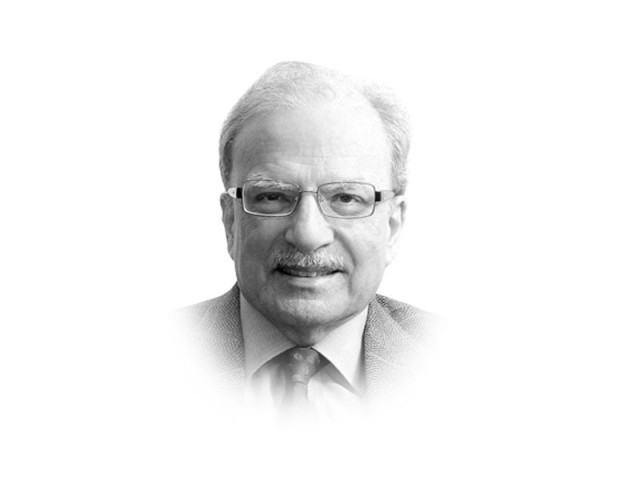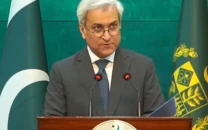Trump’s Mideast approach and South Asia consequences
By supporting an anti-Islam approach, Trump has further churned up the already turbulent waters of the Middle East

The writer is a former caretaker finance minister and served as vice-president at the World Bank
There were two terrorist attacks in Tehran, a city that had largely been spared by those who want to bring chaos to the Muslim world. A quartet of nations — Bahrain, Egypt, Saudi Arabia, UAE and Yemen — severed relations with the tiny but oil-and-gas-rich nation of Qatar. This action by the rulers in the Middle East drew other nations, in particular Turkey, to come out openly in support of the small sheikhdom. President Trump took great pride in the fact that it was his discussions in Riyadh with the Saudi monarch that created the rift.
US farmers slam Trump’s clampdown
How will this spreading crisis affect South Asia, home to 500 million Muslims out of the world’s total of 1.6 billion? Not only does South Asia possess the largest Muslim community in the world, there is also a large Shia presence in the region. Of the estimated 225 million followers of this sect of Islam, 60 million, or more than a quarter of the total, live in Pakistan, India and Afghanistan. Judging by the type of politics Trump’s America is encouraging, there can be no doubt that the sectarian divide in the Muslim world will be exacerbated.
The rise of Shias following the Iranian Islamic Revolution of 1979 sharpened the sense of identity of this community in Pakistan and India. The reaction to this increase in Shia self-consciousness was violence aimed at identifiable members of the community. The Hazaras, a Persian-speaking community with distinct physical features (who reside mainly in central Afghanistan, Hazara Town in Balochistan and Karachi) are overwhelmingly Shia. Of the estimated seven to eight million people belonging to this sect, two and a half million are in Afghanistan and close to one million reside in Pakistan. They have been targeted by extremists in both countries. Over the last few months, there were a number of Hazara deaths in acts of terrorism in Quetta and Karachi in Pakistan.

Nonetheless, the sharpening sectarian divide is not the only likely consequence of Trump’s approach to the Middle East. In recent years, there has been a palpable increase in the influence of Wahhabism in South Asia. All of the reasons that explain this development can be traced to Saudi Arabia. First, the large-scale migration of young men from South Asia became a conduit for the arrival of Wahabism into the region.
Top career US diplomat in China embassy steps down
Since most labour-importing countries in the Middle East allowed only males to come for work for limited periods of times (3 to 5 years) there was a fast turnover among the migrants. Over the last more than four decades, approximately 15 million Pakistanis have moved in and out of the Middle East. About the same number of Muslims from India (in particular from the state of Kerala) similarly migrated. Upon return they brought conservative Islam back to their countries, changing the more liberal traditions of the areas from which they originated.
Second, Saudi Arabia in particular but the well-to-do individuals in other oil-rich countries as well have financially contributed to the establishment of madrassas in South Asia, particularly in Afghanistan and the tribal belt of Pakistan. The first generation of the Taliban was typically graduates from these seminaries.
Third, the flow of official development assistance from Saudi Arabia to Pakistan as well as private direct investment in all parts of South Asia gave the kingdom considerable leverage. Not only Pakistan but India, especially under Prime Minister Narendra Modi, has also been active in bringing in Arab capital.
Fourth, Saudi Arabia has strong military ties with Pakistan. Although the Pakistani National Assembly turned down the Saudi request to send troops to the country to bolster its ability to defend itself, there is possibly an understanding between Riyadh and Islamabad to do so in the event that there is a violation of the Kingdom’s sovereignty. Earlier this year, Raheel Sharif was appointed to a new position to head a multinational force the Saudis were assembling from two-score Muslim countries. Dealing with terrorism was the declared objective of this move.
By openly supporting an anti-Islam approach, Trump has further churned up the already turbulent waters of the Middle East. It is unlikely that there will be a state-to-state confrontation between Saudi Arabia and Iran. What is probable is a fight involving proxies with the restive minorities in Bahrain and Saudi Arabia rebelling against the established order. This is already taking place in Yemen.
The Trump regime is likely to fuel the rise of sectarianism in the Middle East and parts of South Asia. Bangladesh and Pakistan are busy developing participatory and inclusive political institutions. Such institutions must provide space to religious and ethnic minorities. That is the only way sectarian divergences will not translate into violence and killing. In the past, Pakistan was a more tolerant society in which differences among different sects of Islam did not result in violence. Political development emphasising inclusion will help to return the country to tolerance, and this is the policy the United States should be supporting. Unfortunately, this approach is not high on the list of Trump’s priorities.
Published in The Express Tribune, June 20th, 2017.
Like Opinion & Editorial on Facebook, follow @ETOpEd on Twitter to receive all updates on all our daily pieces.














COMMENTS
Comments are moderated and generally will be posted if they are on-topic and not abusive.
For more information, please see our Comments FAQ